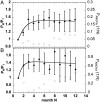A structured exercise programme during haemodialysis for patients with chronic kidney disease: clinical benefit and long-term adherence
- PMID: 26316654
- PMCID: PMC4554901
- DOI: 10.1136/bmjopen-2015-008709
A structured exercise programme during haemodialysis for patients with chronic kidney disease: clinical benefit and long-term adherence
Abstract
Objective: Long-term studies regarding the effect of a structured physical exercise programme (SPEP) during haemodialysis (HD) assessing compliance and clinical benefit are scarce.
Study design: A single-centre clinical trial, non-randomised, investigating 46 patients with HD (63.2 ± 16.3 years, male/female 24/22, dialysis vintage 4.4 years) performing an SPEP over 5 years. The SPEP (twice/week for 60 min during haemodialysis) consisted of a combined resistance (8 muscle groups) and endurance (supine bicycle ergometry) training. Exercise intensity was continuously adjusted to improvements of performance testing. Changes in endurance and resistance capacity, physical functioning and quality of life (QoL) were analysed over 1 year in addition to long-term adherence and economics of the programme over 5 years. Average power per training session, maximal strength tests (maximal exercise repetitions/min), three performance-based tests for physical function, SF36 for QoL were assessed in the beginning and every 6 months thereafter.
Results: 78% of the patients completed the programme after 1 year and 43% after 5 years. Participants were divided--according to adherence to the programme--into three groups: (1) high adherence group (HA, >80% of 104 training sessions within 12 months), (2) moderate adherence (MA, 60-80%), and 3. Low adherence group (LA, <60%)) with HA and MA evaluated quantitatively. One-year follow-up data revealed significant (p<0.05) improvement for both groups in all measured parameters: exercise capacity (HA: 55%, MA: 45%), strength (HA: >120%, MA: 40-50%), QoL in three scores of SF36 subscales and physical function in the three tests taken between 11% and 31%. Moreover, a quantitative correlation analysis revealed a close association (r=0.8) between large improvement of endurance capacity and weak physical condition (HA).
Conclusions: The exercise programme described improves physical function significantly and can be integrated into a HD routine with a high long-term adherence.
Keywords: Dialysis < NEPHROLOGY; SPORTS MEDICINE.
Published by the BMJ Publishing Group Limited. For permission to use (where not already granted under a licence) please go to http://group.bmj.com/group/rights-licensing/permissions.
Figures




Similar articles
-
Complete low-intensity endurance training programme in haemodialysis patients: improving the care of renal patients.Nephron Clin Pract. 2014;128(3-4):387-93. doi: 10.1159/000369253. Epub 2014 Dec 17. Nephron Clin Pract. 2014. PMID: 25531587
-
Exercise in patients with non-small cell lung cancer.Med Sci Sports Exerc. 2014 Apr;46(4):656-63. doi: 10.1249/MSS.0000000000000158. Med Sci Sports Exerc. 2014. PMID: 24042307
-
Benefits of a low intensity exercise programme during haemodialysis sessions in elderly patients.Nefrologia. 2015;35(4):385-94. doi: 10.1016/j.nefro.2015.03.006. Epub 2015 Jul 21. Nefrologia. 2015. PMID: 26306966 Clinical Trial. English, Spanish.
-
The development of an evidence-based physical self-management rehabilitation programme for cancer survivors.Patient Educ Couns. 2008 May;71(2):169-90. doi: 10.1016/j.pec.2007.11.027. Epub 2008 Feb 5. Patient Educ Couns. 2008. PMID: 18255249 Review.
-
Effect of exercise training on functional capacity, muscle strength, exercise capacity, dialysis efficacy and quality of life in children and adolescents with chronic kidney disease: a systematic review and meta-analysis.Int Urol Nephrol. 2024 Jun;56(6):1939-1951. doi: 10.1007/s11255-023-03887-5. Epub 2023 Dec 6. Int Urol Nephrol. 2024. PMID: 38055100
Cited by
-
Intradialytic resistance training: an effective and easy-to-execute strategy.J Bras Nefrol. 2018 Nov 8;41(2):215-223. doi: 10.1590/2175-8239-jbn-2018-0134. J Bras Nefrol. 2018. PMID: 30421780 Free PMC article.
-
Perceived Exertion Correlates with Multiple Physiological Parameters During Cardiopulmonary Exercise Testing.Adv Exp Med Biol. 2022;1395:423-427. doi: 10.1007/978-3-031-14190-4_69. Adv Exp Med Biol. 2022. PMID: 36527673
-
Dietary Protein and Physical Activity Interventions to Support Muscle Maintenance in End-Stage Renal Disease Patients on Hemodialysis.Nutrients. 2019 Dec 5;11(12):2972. doi: 10.3390/nu11122972. Nutrients. 2019. PMID: 31817402 Free PMC article.
-
Kinesiologist-guided functional exercise in addition to intradialytic cycling program in end-stage kidney disease patients: a randomised controlled trial.Sci Rep. 2020 Mar 31;10(1):5717. doi: 10.1038/s41598-020-62709-1. Sci Rep. 2020. PMID: 32235852 Free PMC article. Clinical Trial.
-
Randomized Controlled Trial of Exercise in CKD-The RENEXC Study.Kidney Int Rep. 2019 Apr 9;4(7):963-976. doi: 10.1016/j.ekir.2019.04.001. eCollection 2019 Jul. Kidney Int Rep. 2019. PMID: 31312771 Free PMC article.
References
Publication types
MeSH terms
LinkOut - more resources
Full Text Sources
Other Literature Sources
Medical
